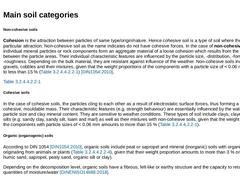
|
Non-cohesive soils Cohesion is the attraction between particles of same type/origin/nature. Hence cohesive soil is a type of soil where there is an inter-particular attraction. Non-cohesive soil as the name indicates do not have cohesive forces. In the case of non-cohesive soils, the individual mineral particles or rock components form an aggregate material of a loose cohesion which results from the friction between the particle areas. Their individual … |
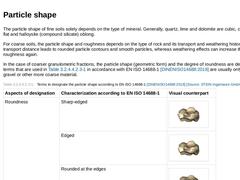
|
The particle shape of fine soils solely depends on the type of mineral. Generally, quartz, lime and dolomite are cubic, clay minerals flat and halloysite (compound silicate) oblong. For coarse soils, the particle shape and roughness depends on the type of rock and its transport and weathering history. A longer transport distance leads to rounded particle contours and smooth particles, whereas weathering effects can increase the particle roughness … |
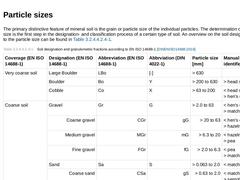
|
The primary distinctive feature of mineral soil is the grain or particle size of the individual particles. The determination of the particle size is the first step in the designation- and classification process of a certain type of soil. An overview on the soil designation subject to the particle size can be found in Table 1‑15. (Table: Soil designation and granulometric fractions according to EN ISO 14688-1 (06.2011)) The so-called granulometric fraction |
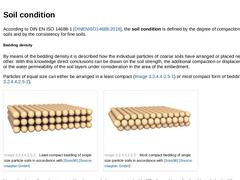
|
According to DIN EN ISO 14688-1 [DINENISO14688:2018], the soil condition is defined by the degree of compaction for coarse soils and by the consistency for fine soils. Bedding density By means of the bedding density it is described how the individual particles of coarse soils have arranged or placed next to each other. With this knowledge direct conclusions can be drawn on the soil strength, the additional compaction or displacement capability or the … |
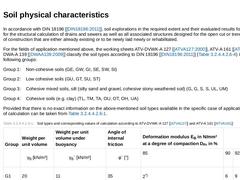
|
In accordance with DIN 18196 [ [DIN18196:2011]], soil explorations in the required extent and their evaluated results form the basis for the structural calculation of drains and sewers as well as all associated structures designed for the open cut or trenchless method of construction that are either already existing or to be newly laid newly or rehabilitated. For the fields of application mentioned above, the working sheets ATV-DVWK-A 127 [ [ATVA127:… |
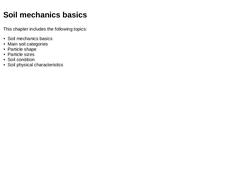
|
|
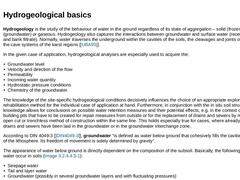
|
Hydrogeology is the study of the behaviour of water in the ground regardless of its state of aggregation – solid (frozen), liquid (groundwater) or gaseous. Hydrogeology also captures the interactions between groundwater and surface water (receiving water and bank filtrate). Normally, water traverses the underground within the cavities of the soils, the cleavages and joints of rocks and the cave systems of the karst regions [ [UBA93]]. In the given … |
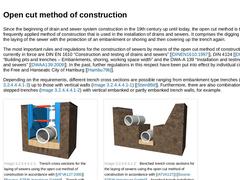
|
Since the beginning of drain and sewer system construction in the 19th century up until today, the open cut method is the most frequently applied method of construction that is used in the installation of drains and sewers. It comprises the digging of a trench, the laying of the sewer with the protection of an embankment or shoring and then covering up the trench again. The most important rules and regulations for the construction of sewers by means … |
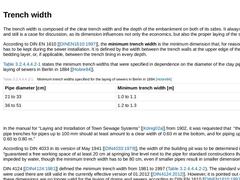
|
The trench width is composed of the clear trench width and the depth of the embankment on both of its sides. It always has been and still is a case for discussion, as its dimension influences not only the economics, but also the proper laying of the sewer. According to DIN EN 1610 [ [DINEN1610:1997]], the minimum trench width is the minimum dimension that, for reasons of safety, has to be kept during the sewer installation. It is defined by the width … |
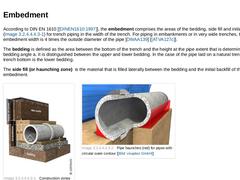
|
According to DIN EN 1610 [ [DINEN1610:1997]], the embedment comprises the areas of the bedding, side fill and initial backfill (Image 1‑43) for trench piping in the width of the trench. For piping in embankments or in very wide trenches, the embedment width is 4 times the outside diameter of the pipe [ [DWAA139:2009]] [ [ATVA127c]]. The bedding is defined as the area between the bottom of the trench and the height at the pipe extent that is determined … |
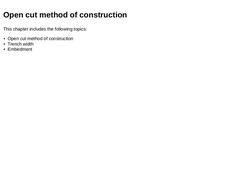
|
|
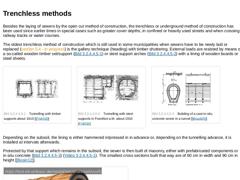
|
Besides the laying of sewers by the open cut method of construction, the trenchless or underground method of construction has been used since earlier times in special cases such as greater cover depths, in confined or heavily used streets and when crossing railway tracks or water courses. The oldest trenchless method of construction which is still used in some municipalities when sewers have to be newly laid or replaced (section 5.4 - in progress) … |
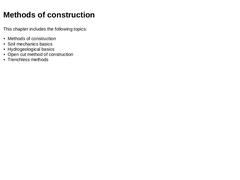
|
|
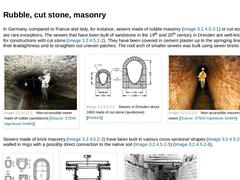
|
In Germany, compared to France and Italy, for instance, sewers made of rubble masonry (Image 1‑83) or cut stone masonry are rare exceptions. The sewers that have been built of sandstone in the 19th and 20th century in Dresden are well-known examples for constructions with cut stone (Image 1‑84). They have been covered in cement plaster up to the springing line to achieve their leaktightness and to straighten out uneven patches. The roof arch of smaller … |
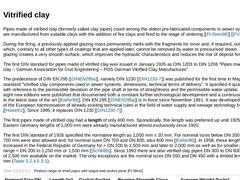
|
Pipes made of vitrified clay (formerly called clay pipes) count among the oldest pre-fabricated components in sewer systems. They are manufactured from suitable clays with the addition of fire clays and fired to the stage of sintering [ [FI-Stein96]] [ [FVS78]]. During the firing, a previously applied glazing mass permanently melts with the fragments for inner and, if required, outer glazing, which, contrary to all other types of coatings that are … |
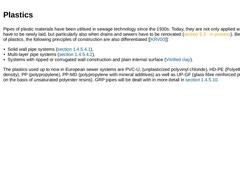
|
Pipes of plastic materials have been utilised in sewage technology since the 1930s. Today, they are not only applied when sewers have to be newly laid, but particularly also when drains and sewers have to be renovated (section 5.3 - in process). Besides the type of plastics, the following principles of construction are also differentiated [ [KRV00]]: -
Solid wall pipe systems ( (Solid wall pipe systems)),
-
Multi-layer pipe systems ( (Systems with profiled …
|
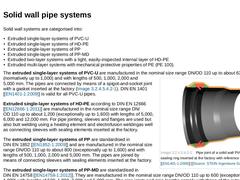
|
Solid wall systems are categorised into: -
Extruded single-layer systems of PVC-U
-
Extruded single-layer systems of HD-PE
-
Extruded single-layer systems of PP
-
Extruded single-layer systems of PP-MD
-
Extruded two-layer systems with a light, easily-inspected internal layer of HD-PE
-
Extruded multi-layer systems with mechanical protective properties of PE (PE 100).
(Image: Pipe joint of a solid wall PVC-U pipe with a sealing ring inserted at the factory … |
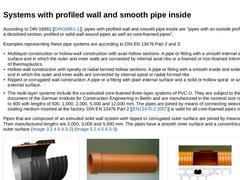
|
According to DIN 16961 [ [DIN16961-1]], pipes with profiled wall and smooth pipe inside are “pipes with an outside profile, pipes with a dissolved section, profiled or solid wall wound pipes as well as core-foamed pipes”. Examples representing these pipe systems are according to DIN EN 13476 Part 2 and 3: -
Multilayer construction or hollow-wall construction with axial hollow sections: A pipe or fitting with a smooth internal and external surface and …
|
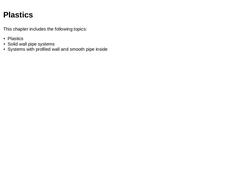
|
|
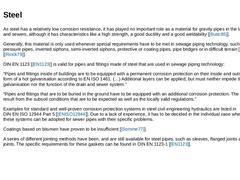
|
As steel has a relatively low corrosion resistance, it has played no important role as a material for gravity pipes in the laying of drains and sewers, although it has characteristics like a high strength, a good ductility and a good weldability [ [Buttc85]]. Generally, this material is only used whenever special requirements have to be met in sewage piping technology, such as for pressure pipes, inverted siphons, semi-inverted siphons, protective … |
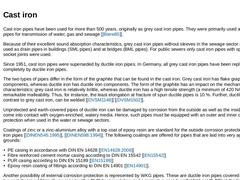
|
Cast iron pipes have been used for more than 500 years, originally as grey cast iron pipes. They were primarily used as pressure pipes for transmission of water, gas and sewage [ [Biere85]]. Because of their excellent sound absorption characteristics, grey cast iron pipes without sleeves in the sewage sector are primarily used as drain pipes in buildings (SML pipes) and at bridges (BML pipes). For public sewers only cast iron pipes with spigot-and-… |
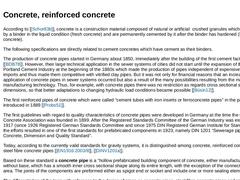
|
According to [ [Schor83b]], concrete is a construction material composed of natural or artificial crushed granules which are encased by a binder in the liquid condition (fresh concrete) and are permanently cemented by it after the binder has hardened (hard concrete). The following specifications are directly related to cement concretes which have cement as their binders. The production of concrete pipes started in Germany about 1850, immediately after … |
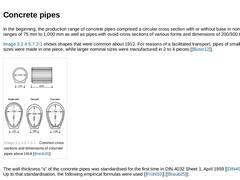
|
In the beginning, the production range of concrete pipes comprised a circular cross section with or without base in nominal size ranges of 75 mm to 1,000 mm as well as pipes with ovoid cross sections of various forms and dimensions of 200/300 to 1,000/1,500. Image 1‑112 shows shapes that were common about 1912. For reasons of a facilitated transport, pipes of smaller nominal sizes were made in one piece, while larger nominal sizes were manufactured … |
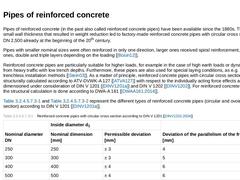
|
Pipes of reinforced concrete (in the past also called reinforced concrete pipes) have been available since the 1880s. The relatively small wall thickness that resulted in weight reduction led to factory-made reinforced concrete pipes with circular cross section up to DN 2,500 already at the beginning of the 20th century. Pipes with smaller nominal sizes were often reinforced in only one direction, larger ones received spiral reinforcement, very large … |
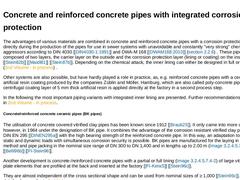
|
The advantages of various materials are combined in concrete and reinforced concrete pipes with a corrosion protection applied directly during the production of the pipes for use in sewer systems with unavoidable and constantly "very strong" chemical aggressors according to DIN 4030 [ [DIN4030-1:1991]] and DWA-M 168 [ [DWAM168:2010]] ( (Surface damage (BAF))) . These pipes are composed of two layers, the carrier layer on the outside and the corrosion … |